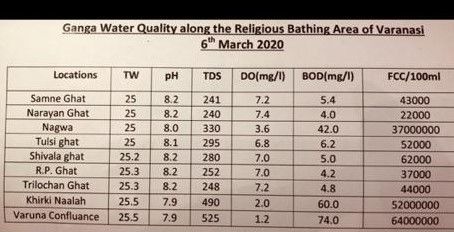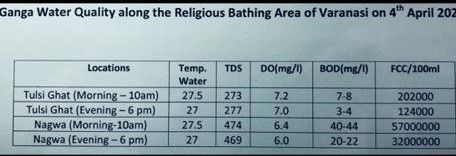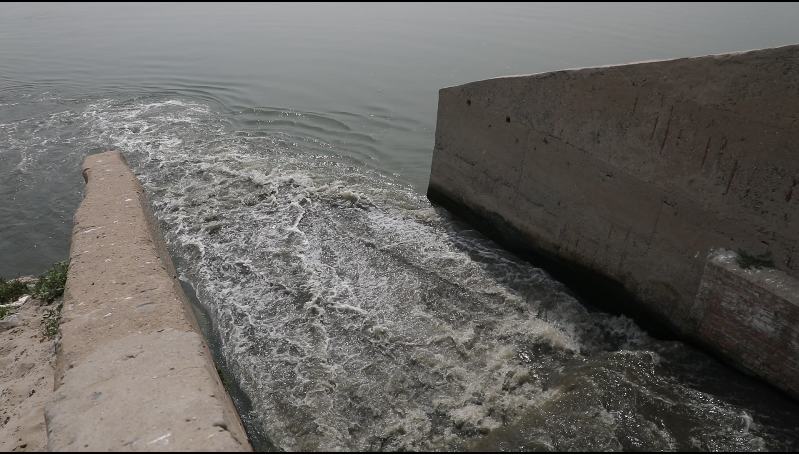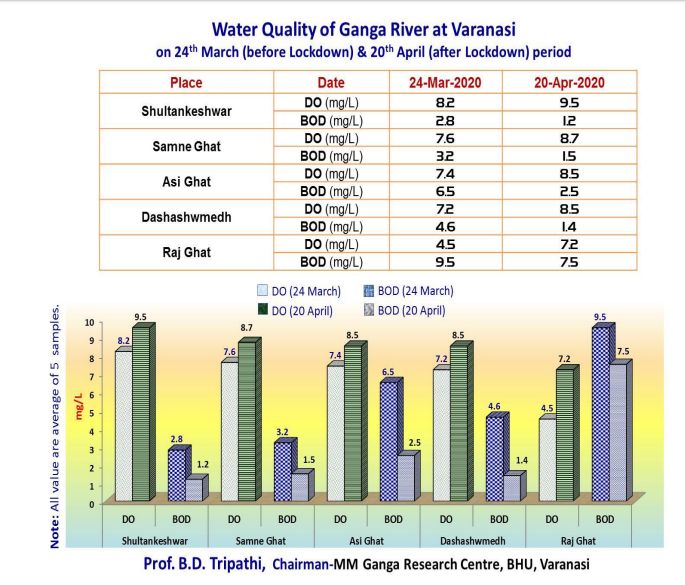Is the Ganga clean after the lockdown?
Gaon Connection visited Varanasi and as per an expert who was interviewed for the story, sewage water from residential areas is still flowing into the river, so it would be incorrect to say that the river is clean now

Several reports mention that the Ganga river has become clean during the lockdown. Many pictures are circulating which show that the Ganga water is clear and transparent. Is that the case?
Gaon Connection visited Varanasi in Uttar Pradesh to find out whether the Ganga has really been cleaned up during the lockdown. We spoke to the BHU IIT professor and the chairman of the Sankat Mochan Foundation, Vishambhar Nath Mishra. The Clean Ganga Research Laboratory of the Sanket Mochan Foundation has been regularly testing the water from the Ganga.
Mishra said: “Ninety per cent of the raw sewage comes out of homes in Varanasi. The case of Kanpur is different because there we have industries. People are currently in their homes. Those who were outside have also returned home.”
He added: “Lockdown or not, sewage from the residential areas is sure to come to the Ganges. The presence of fecal coliform in the Ganga is an indication that sewage water is coming into the Ganges. So, it is not correct to say that the Ganga is clean after the lockdown.”
A group of bacteria in human and cattle feces is called fecal coliform.
The Sankat Mochan Foundation had examined the Ganga water before the lockdown. On March 6, the DO (dissolved oxygen) near the Nagwa Nallah in Varanasi was 3.6 mg per litre and at the Tulsi Ghat it was 6.8 mg per litre. On April 4, it had increased to 6.4 mg in the Nagwa Nallah and at Tulsi ghat to 7.2 mg per litre.
Water contains oxygen. When the amount of harmful chemicals in water is high, the oxygen level decreases. Dissolved oxygen is measured in milligrams per litre.
The DO level is considered good above five milligrams per litre. This means that the condition of the dissolved oxygen has improved, but has the Ganga really become clean?
In this regard, Mishra said: “The experts of the Ganga affairs and even the government has admitted that even with all the efforts we may only be able to make the Ganga a Class B river. A Class B River means that water is only bath- worthy. It means that if all the government’s steps yield positive results, the Ganga water would only become bath-worthy. One cannot drink from it still.”
He believes that unless the fecal coliform in water comes within 500 per 100 ml, we cannot say that the Ganges is actually clean. All the reports that are claiming so, are not being providing full information.
He said: “Talking about a Class B river, the BOD (biochemical oxygen dissolve) level should be less than 3 mg per litre. The DO (dissolved oxygen) level should be above five milligrams per litre and the fecal coliform should be within 500 per 100 ml. Only when the water of the river is at this stage, it will be bath-worthy. You cannot talk about drinking such water nor do aachman with it. Unless the level of fecal coliform in water becomes zero, we can’t drink it. Where we are sitting (Tulsi Ghat), in March, here the fecal coliform was 52,000 in one millimetre of water, which should be within 500. Then, during the lockdown, it had increased to three times more.”

As per the records of the Sankat Mochan Foundation, on March 6, at the front ghat, the TDS (Total Dissolved Solids) was 241, the DO level 7.2 and the BOD level 5.4, while the number of fecal coliform was 43,000 per ml. Its number at the Narayan Ghat was 22,000 per ml, 37,000,000 at the Nagwa Ghat, 52,000 at the Tulsi Ghat, 62,000 at the Shivalaya Ghat, 37,000 at the RP Ghat, 44,000 at the Trilochan Ghat, 52,000,000 at the Khirki Nallah and 64,000,000 at the Varun-Ganga confluence.

The standards say that the quantity of the TDS (total dissolved solids) in river water should be less than 600 mg per litre.
The samples were taken from the Tulsi Ghat and Nagwa Ghat on April 4 during the lockdown by the foundation. The investigation revealed that the water of Tulsi Ghat had a TDS of 273, the DO level at 7.2, the BOD level at 7.8 and the FCC level of 202,000 in the morning of that day, while the TDS was 474, the DO 6.4, the BOD 40-40 and the FCC 57,000,000 at the Nagwa Ghat.
Mishra said that since the chemical water is not coming to the river due to the lockdown, its water is looking clean. The number of fecal coliform in one millimetre of water in March near the Assi Ghat was 37 million (37,000,000). In April, when it was said that the Ganga water had become clear, its level had, in fact, reached 57 million.

While continuing, he further said that it is written in the Ramcharitmanas that Daras Paras Majjan Aru Paana. Many people visit the Ganges. Many people anoint their foreheads with the holy water of the Ganges, many people bathe in the Ganges and many people also do achaman. Now, when we do achaman, there should no fecal coliform in water. There are many people who spend their whole life upon the Ganges water. How can a man drink water with fecal coliform?
Now in the lockdown if someone feels that everything is okay, so be it. We are monitoring every day. All the water-borne diseases are due to the fecal coliform. If you are not able to remove it, there is no point in cleanliness.
Two new Sewage Treatment Plants (STPs) have now been installed in Banaras. One is at Dinapur having a capacity of 140 MLD (million litres per day). The second STP has been installed at Satwan with a capacity of 120 MLD. In one, 60 MLD sewage was transported, in the other, 10 MLD. God only knows in what state they are currently in. In the Varuna too, the sewage is being flown directly.

In 1986, when the Ganga cleaning had begun in Banaras, the discharge of Banaras was about 150 MLD. Three STPs, one in DLW, one at Bhagwanpur and one at Dinapur were set up with a total capacity of a mere 102 MLD. As one can easily see that the treatment capacity is already less than the requirement. And now, about 350 MLD discharge is happening every day.
The Sankat Mochan Foundation examined the water of a few ghats on May 20, May 22, May 28 and June one. According to the report, Tulsi Ghat’s TDS was 282, DO 6.8, BOD 10 and FCC 83,000 on May 20. The TDS at the Nagwan Ghat was 330, DO 4.8, BOD 37 and FCC 52,000,000.
Similarly, on May 22, samples were taken from these two ghats. In this report Tulsi Ghat had TDS 274, DO 7.0, BOD 9 and FCC 76,000 whereas the TDS at Nagwan Ghat was 330, DO 4, BOD 39 and FCC 60,000,000.
On May 28, the FCC’s number at Tulsi Ghat was 68,000 per 100 ml and the FCC level at the same ghat on June 1 was 57,000. Now, based upon this report, it cannot be said that there has been a huge change in the number of fecal coliform due to the lockdown. It has been constantly fluctuating.

According to Mishra, there exists no technique to eliminate fecal coliform in the STPs (sewage treatment plant) that are used for water treatment. The Ganga Action Plan mentions that all pollution from the Ganga should be eliminated. And only when the water is not harmful in any way, it should be considered treated and used.
When the water is not rid of its fecal coliform content, how can it be considered as treated? The sewage water is lightly treated before flowing it into the Ganges. The rest of the dirty water that is more than the capacity is anyhow being discharged directly into the Ganges.
He also says that we are showing actual pictures that the water of the Ganges has become clean. The Ganges is so beautiful otherwise too. Whenever you talk about water cleanliness, whatever report is coming, it is being said that the BOS level has improved. The BOS level will improve because human activities have decreased at the ghats and the dust or dirt that is there is actually deposited in the water below. Due to this, the water transparency has also increased. The question is why investigators do not talk about fecal coliform. It is not that the Ganges is polluted everywhere. The pollution is there where there is a population. Now, if someone goes further deeper into the river and takes water and examines it, one would find it clear anyway. But do we go to the middle of the Ganges to bathe or worship? Water should be clean where it is accessed by the population.
In this regard, we spoke on the phone to Prof BD Tripathi, chairman, Mahamana Malaviya Ganga, the River Development and Water Resources Management Research Centre, Banaras Hindu University, Varanasi.

He explained: “During the lockdown, the Ganga water has decreased by 25 to 30 per cent. The BOD content has decreased. The amount of DO has increased considerably. Based on the norms, it can be said that the pollution level in Ganga water has decreased. We have not worked on the fecal coliform.”
“The lockdown has restricted human activity. The cremation of dead bodies in Kashi has gone down by more than 40 per cent. Workshops of more than 500 motor vehicles are closed. Kashi has about 1,200 factories of silk fabric and ivory works. These factories release about 25 MLD of dirty water. Fish and turtles were also seen in the Ganga during the sampling in the lockdown,” BD Tripathi informed.

